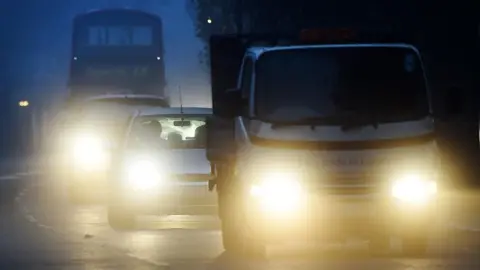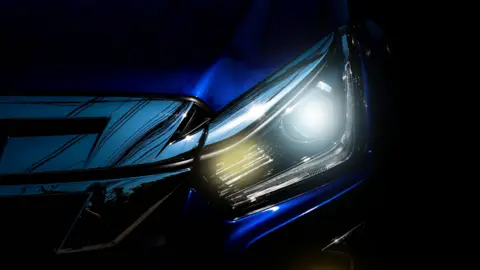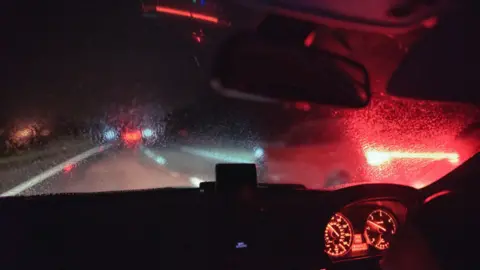Katy Austin,Transport correspondent and
Lucy Hooker,Business Reporter
 EPA
EPACriticism from drivers over the dazzle from oncoming headlights has prompted the government to take a closer look at the design of cars and headlamps on UK roads.
Drivers say LED headlamps, which are increasingly common in new vehicles, are causing them problems and making it harder to drive at night.
Research into the issue on behalf of the Department for Transport (DfT) has still not been published, but the BBC has learned that the government now plans to launch a new assessment of the causes and remedies.
New measures will be included in the government’s upcoming Road Safety Strategy, reflecting what is becoming an increasingly fraught issue for road users.
Both Ruth Goldsworthy and Sally Burt say bright headlights make it harder for them to get to their weekly SO Sound choir meetings in Totton, in Hampshire.
“Some of the lights are so bright you are blinded by them, for seconds,” says Ruth.
The beam from LED headlights is whiter, more focused and brighter than the more diffuse light from halogen lamps fitted in older cars.
“I’m not sure where to look, I look into the gutter,” says Sally. They are both relieved if someone else offers to drive.
Night driving becomes a bigger problem as the winter evenings draw in, and especially after the clocks change, which means more people are driving in the dark.

Linda, from Bristol, told BBC 5 Live’s Nicky Campbell the intensity of the brightness was “unnecessary and horrible”.
“It actually hurts my eyes it’s so bright. So I tend to avoid driving at night now because it is such a horrible experience for me.”
Mike, a bus driver in Scarborough, also called in to say the bright lights can cause confusion on the roads.
“You can’t tell if these cars are flashing you or not,” he said.
Dorothy Pickering, 85, from Berkshire, contacted the BBC to say she had adapted the steering wheel of her car so she could drive it following a stroke in 2020, which left her disabled.
She said she had “always loved driving and have driven in numerous countries” but no longer drives at night, because the “lights and SUV vehicles are a definite problem”.
Kate Phillips, 75, from Southampton, also said she had stopped driving at night “because the brighter lights dazzle me”.
She said the constant stream of oncoming traffic on long straight roads “really strains my eyes” and made driving uncomfortable.
The problem is worse for older people, whose eyes take around nine seconds to recover from glare, compared to one second for a 16-year-old, according to road safety consultant, Rob Heard.
“In severe cases, we might need to stop until our sight can recuperate,” he said.
A survey from the RAC motoring organisation found that more than a third of drivers were nervous about getting behind the wheel as the evenings get darker. Three quarters of respondents said driving was getting more difficult due to brighter lights.
The RAC’s senior policy officer, Rod Dennis, said so far little progress has been made on tackling glare, with regulations governing headlights dating back to 1989.
A DfT spokesperson said: “We know headlight glare is frustrating for many drivers, especially as the evenings get darker.”
What to do in the face of brighter headlamps:
- Ensure your windscreen is clean
- Wear glasses and keep them clean
- Avoid looking straight ahead, instead focus on the edge of the road
- Do not wear night sunglasses sold for night-driving, as they reduce overall light and won’t reduce glare.
Source: College of Optometrists
New research
The results of last winter’s government commissioned research into the “causes and impact of glare” are now expected in the next few weeks, the DfT said.
They will inform the upcoming Road Safety Strategy, which is also expected to tighten rules on drink-driving and eye-sight tests for older drivers.
The BBC understands the government is commissioning new research into the role of vehicle design in causing glare, and possible solutions, which will feed into international discussion of the issue.
 Getty Images
Getty ImagesOne already well-understood source of glare is drivers retrofitting their vehicles, replacing old halogen bulbs with LEDs.
The housing for halogen bulbs is not compatible with LED bulbs, and a retrofitted car will not pass its annual MOT check-up.
As part of the government’s new approach the Driver and Vehicle Standards Agency has “stepped up surveillance” to stop the sale of illegal retrofit headlamp bulbs, the DfT said.
Seeing better
Cars sold with LED lights can improve road safety by helping drivers to see better, Thomas Broberg, senior adviser for safety at Volvo told the BBC.
However, avoiding dazzle was “equally important”, he said.
“I would say poor aiming of the headlights and also the road shape are the major factors for glare,” he said.
For larger vehicles, such as SUVs, where lights are higher off the ground, the beam must point more sharply downwards, to protect oncoming drivers. But the angle can be affected by how many passengers it is carrying.
Some new cars with “adaptive features” adjust the lamps automatically if there is a change in load, but cars without that will need manual adjusting, Mr Broberg said.
Some new cars also have automatic headlamp dipping, which lowers the lights when an oncoming vehicle is detected.
However, Daniel Harriman-McCartney, clinical advisor at the College of Optometrists, said automatic dimming features can be “slow to kick in”.
 Getty Images/Stephen Robinson Pictures
Getty Images/Stephen Robinson PicturesDazzling headlights are cited as a factor in around 250 accidents a year, but there is no evidence that brighter lights are causing more collisions than previously, the RAC concedes.
Instead, worried drivers may simply be “taking the risk off the road” by not driving at night, with a big social impact, the RAC’s Mr Dennis warned.
He would like to see action that “strikes a balance”.
“We don’t want to go back to worse headlights. It is about what is bright enough.”
Disclaimer : This story is auto aggregated by a computer programme and has not been created or edited by DOWNTHENEWS. Publisher: BBC






